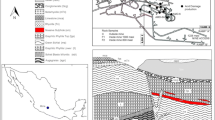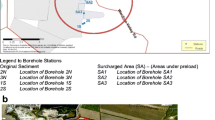Abstract
Surface water enters the Haile Gold Mine, Lancaster County, South Carolina by means of a small stream and is ponded behind a dam and in an abandoned pit. This water is affected by acidic drainage. In spite of the large exposures of potentially acid producing pyritic rock, the flux of acid to the water is relatively low. Nevertheless, the resulting pH values of the mine water are low (around 3.5) due to negligible buffering capacity. In view of the observed low release of acidity, the potential for acid drainage abatement by limestone ameliorants appears feasible.
This study investigated the effects of limestone treatment on acid generation rates of the Haile mine pyritic rocks through a series of leaching experiments. Below a critical alkalinity threshold value, solutions of dissolved limestone were found consistently to accelerate the rate of pyrite oxidation by varying degrees. The oxidation rates were further accelerated by admixing solid limestone with the pyritic rock. However, after a period of about a month, the pyrite oxidation rate of the admixed samples declined to a level lower than that of untreated pyrite. Leachates produced by the pyrite and limestone mixtures contained little if any iron. Further, in the mixtures, an alteration of the pyrite surface was apparent.
The observed behaviour of the treated pyrite appears to be related to the immersion of the pyrite grains within a high alkalinity/high pH environment. The high pH increases the rate of oxidation of ferrous iron which results in a higher concentration of ferric iron at the pyrite surface. This, in turn, increases the rate of pyrite oxidation. Above a threshold alkalinity value, the precipitation of hydrous iron oxides at the pyrite surface eventually outpaces acid generation and coats the pyrite surface, retarding the rate of pyrite oxidation.
Similar content being viewed by others
References
Anonymous. 1970. Oxygenation of Ferrous Iron: Harvard University, Cambridge, Massachusetts, Federal Water Quality Administration. U.S. Department of the Interior. Contract PH 36-66-107.
Berner, R.A. & Morse, J.W. 1974. Dissolution kinetics of calcium carbonate in sea water IV. Theory of calcite dissolution.American Journal of Science 274, 108–134.
Caruccio, F.T., Geidel, G. & Pelletier, M. 1981. Occurrence and Prediction of acid drainages.Journal of the Energy Divison. ASCE 107(EYI), 167–178. Proceedings Paper 16278.
Caruccio, F.T. 1968. An evaluation of factors affecting acid mine drainage and the groundwater interactions in selected areas of western Pennsylvania. Second Symposium on Coal Mine Drainage Research. Pittsburgh. Pennsylvania. 107–151.
Geidel, G. 1979. Alkaline and acid production potentials of overburden material: The Rate of Release.Reclamation Review 2, 101–107.
Infanger, M. & Hood, N.C. 1980. Positioning acid-producing overburden for minimal pollution. Symposium of Surface Mining Hydrology, Sedimentology and Reclamation. University of Kentucky, Lexington, Kentucky, 325–332.
Kleinmann, R. 1981. Proceedings of the West Virgina Acid Mine Drainage Task Force Meeting. Clarksburg. West Virginia.
Paciorek, K.L., Kimble, P.F., Vatasescu, A.L., Toben, W.A. & Kratzer, R.H. 1980. Investigation of mechanics of mine acid formation. Volume 1: Ultrasystems, Inc., Irvine. California. U.S. Department of Energy, Contract ET-78-C-01-8977, 132 pp.
Silverman, M.P. 1967. Mechanism of bacterial pyrite oxidation.Journal of Bacteriology 94, 1046–1050.
Silverman, M.P., Rogoff, M.H. & Wender, H. 1961. Bacterial oxidation of pyritic materials in coal.Applied Microbiology 9, 491–496.
Smith, E.E. & Shumate, L.S. 1970. Sulfide to sulfate reaction mechanism. Water Pollution Control Series. 14010 FPS Os/70. E.P.A. Superintendent of Documents. Washington, D.C. 115 pp.
Spence, N.H., Worthington J.E., Jones, E.M., & Kiff, I.T. 1980. Origin of the gold mineralization at the Haile Mine. Lancaster County, South Carolina.Mining Engineering 32, 70.
Stumm, W. & Morgan, J.J. 1970. Aquatic Chemistry. Wiley-Interscience. 583 pp.
Temple, L.L. & Delchamps, E.W. 1953. Autotrophic bacteria and the formationof acid in bituminous coal mines.Applied Microbiology 1, 255–258.
Author information
Authors and Affiliations
Rights and permissions
About this article
Cite this article
Burt, R.A., Caruccio, F.T. The effect of limestone treatments on the rate of acid generation from pyritic mine gangue. Environ Geochem Health 8, 71–78 (1986). https://doi.org/10.1007/BF02311025
Received:
Accepted:
Issue Date:
DOI: https://doi.org/10.1007/BF02311025




